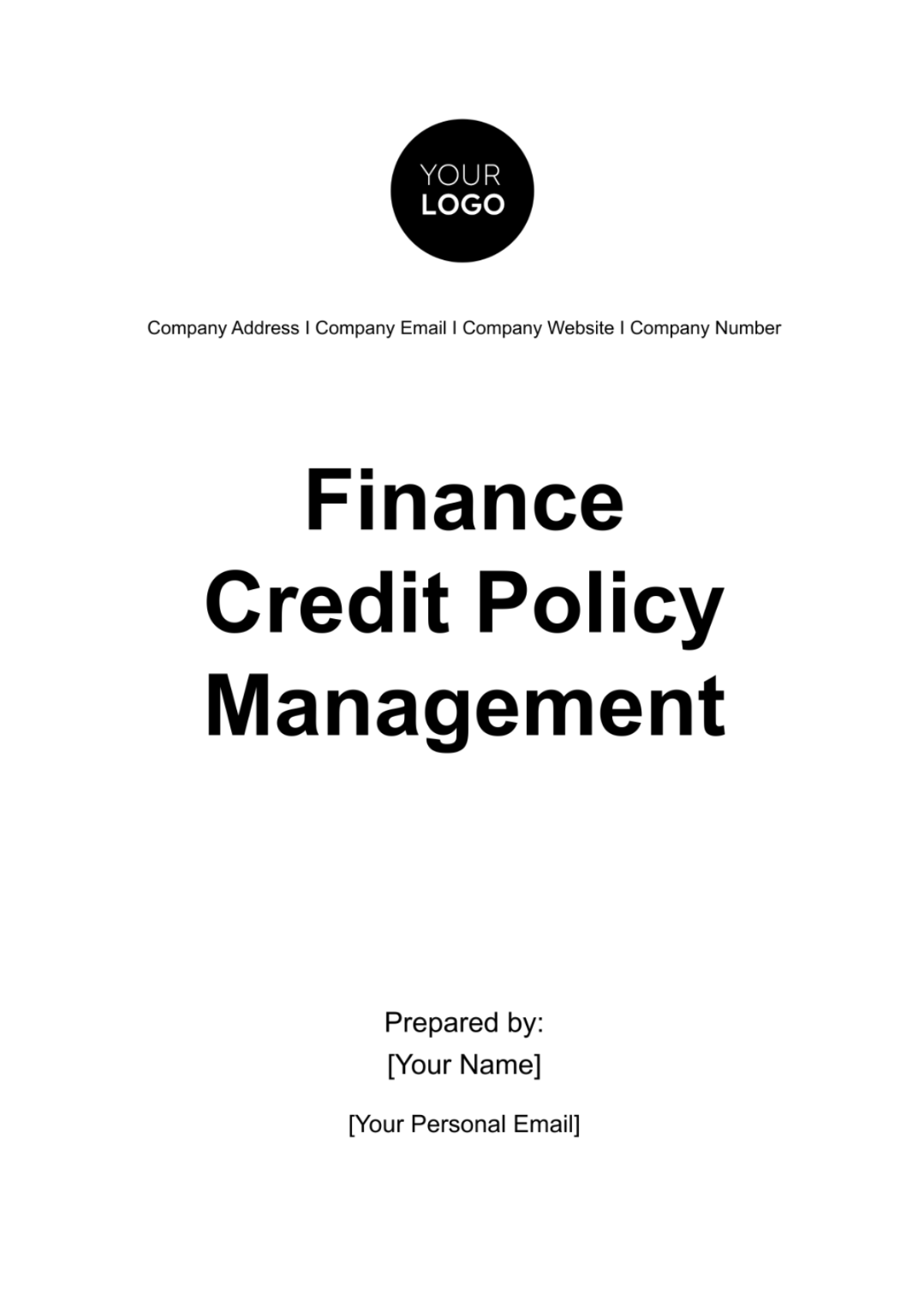Free Finance Credit Policy Management

1. Purpose and Scope
The primary objective of our Finance Credit Policy is to establish a robust framework that governs the extension of credit to our customers. This policy is designed to optimize the balance between increasing sales through credit extensions and minimizing the risk of financial loss from unpaid debts. By clearly defining the criteria and processes for credit evaluation, approval, and management, we aim to enhance our financial stability and customer relations while adhering to the prevailing legal and ethical standards in the United States financial sector.
This policy applies universally across all departments of [Your Company Name] that deal with credit transactions. It is essential for all employees involved in the credit process, from the initial customer assessment to the final debt collection, to understand and adhere to this policy. Regular training and updates will be provided to ensure compliance and adaptability to any changes in legal regulations or market conditions. This comprehensive approach ensures that our credit management aligns with our strategic financial goals and legal obligations, providing a solid foundation for our business operations.
2. Organizational Structure and Responsibilities
Role | Responsibilities |
|---|---|
Board of Directors | Final approval of the Finance Credit Policy |
CFO (Chief Financial Officer) | Overseeing the implementation of the policy |
Account Management Team | Executing daily operations following the policy guidelines |
Risk Management Team | Ensuring regular risk assessments and reports |
3. Credit Limits
Establishing appropriate credit limits is a critical component of our Finance Credit Policy at [Your Company Name]. Our approach is tailored to balance risk and opportunity, taking into account each customer's unique financial standing and history with our company. The following guidelines outline how we set and adjust credit limits.
Initial Credit Assessment
New Customers: For first-time customers, the initial credit limit is determined based on a comprehensive assessment of their credit score, financial health, and industry reputation.
Existing Customers: For customers with an existing relationship, the initial limit is set based on past payment behaviors, order history, and any changes in their financial status.
Creditworthiness Evaluation
High-Risk Category: Customers with lower credit scores or inconsistent payment histories are assigned lower credit limits to mitigate potential risks.
Medium-Risk Category: Customers with moderate credit scores and stable payment histories are granted moderate limits, reflecting a balanced approach.
Low-Risk Category: Customers demonstrating strong creditworthiness, high credit scores, and consistent payment histories are eligible for higher credit limits.
Periodic Review and Adjustment
Regular Reviews: Credit limits are reviewed at least annually or more frequently if significant changes in a customer's financial situation occur.
Adjustments: Increases in credit limits may be considered for customers with improved credit scores or excellent payment records. Conversely, limits may be reduced for customers showing deteriorating financial conditions or irregular payment patterns.
Special Considerations
Market Trends: We consider broader economic and industry-specific trends that might impact customers' financial stability.
Legal and Regulatory Compliance: All decisions regarding credit limits comply with U.S. laws and financial regulations to ensure ethical and fair treatment of all customers.
Through these structured guidelines, [Your Company Name] aims to maintain a healthy balance between sales growth and risk management, ensuring that our credit limit setting process is dynamic, fair, and reflective of each customer's financial reality.
4. Resource Allocation and Budgeting
Activity | Allocation |
|---|---|
Credit risk assessment | 20% of annual budget |
Information systems | 15% of annual budget |
Staff training | 10% of annual budget |
Contingency fund | 10% of annual budget |
5. Risk Management
In [Your Company Name], our Risk Management strategy is integral to maintaining a healthy credit environment. We employ multiple methods to monitor and manage credit risk effectively, ensuring financial stability and minimizing potential losses.
Continuous Credit Monitoring
Regularly review the credit status of all customers, with emphasis on changes in their financial condition, payment patterns, and market dynamics.
Utilize advanced analytics and reporting tools to identify early warning signs of credit risk.
Credit Insurance
Purchase credit insurance to mitigate the risk of significant losses, especially for high-value transactions or customers with variable credit histories.
This insurance covers a portion of the outstanding debt in case of customer default, thereby reducing our exposure.
Guarantees and Collateral
Require personal or corporate guarantees for certain high-risk credit transactions, providing an additional layer of security.
Accept collateral (such as property, inventory, or other valuable assets) where appropriate, to secure credit extended.
Diversification of Credit Portfolio
Avoid concentration of credit risk with any single customer or sector by maintaining a diversified portfolio.
Regularly assess the industry and economic factors that may impact our credit exposure.
Compliance and Legal Standards
Adhere to all relevant U.S. laws and financial regulations in our credit risk management practices.
Ensure documentation and agreements are legally sound and enforceable.
6. Dispute Resolution
The dispute resolution process at [Your Company Name] is designed to address and resolve any disagreements or discrepancies in invoices or payments efficiently and fairly. Our aim is to ensure customer satisfaction while upholding the financial integrity of our transactions. The following table provides a simplified timeline for handling disputes:
Timeframe | Action |
|---|---|
Day 1-3 | Dispute Initiation: Customer raises a dispute. |
Day 4-5 | Acknowledgment: We acknowledge receipt of the dispute. |
Day 6-10 | Investigation: Conduct a thorough review of the dispute. |
Day 11-15 | Resolution Proposal: Propose a solution to the customer. |
Day 16-20 | Customer Feedback: Await customer response to the proposal. |
Day 21-25 | Final Resolution: Agree upon a final solution. |
Day 26-30 | Implementation: Implement the agreed-upon resolution. |
Post-Day 30 | Follow-Up: Ensure resolution satisfaction and document outcomes. |
7. Documentation and Record Keeping
Effective documentation and record-keeping are vital for the integrity and efficiency of credit transactions at [Your Company Name]. We adhere to stringent standards to ensure all necessary records are accurately maintained and easily accessible.
Credit Transaction Documents
Includes credit applications, credit approval documents, contracts, invoices, and payment records.
Legal and Compliance Records
Consists of legal agreements, compliance documents, and any correspondence related to regulatory requirements.
Record Maintenance System
Utilizes a secure, digital record-keeping system for easy retrieval and management of documents.
Data Security and Privacy
Ensures all records are stored securely, with access limited to authorized personnel, in compliance with data protection laws.
Regular Audits and Updates
Conducts periodic audits to verify the accuracy and completeness of records and updates the system as needed.
- 100% Customizable, free editor
- Access 1 Million+ Templates, photo’s & graphics
- Download or share as a template
- Click and replace photos, graphics, text, backgrounds
- Resize, crop, AI write & more
- Access advanced editor
Discover efficiency and compliance with Template.net's Finance Credit Policy Management Template. Expertly crafted, this template provides a comprehensive framework for credit policies, ensuring alignment with U.S. laws and standards. Ideal for streamlining credit processes, it's an indispensable tool for finance professionals seeking clarity and precision in policy formulation. Editable and Customizable using our AI editor tool for your convenience.





























